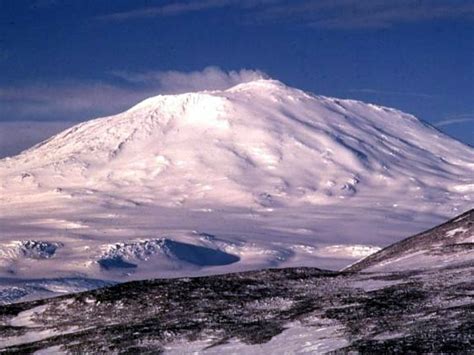
A previously unexplored mountain range in Antarctica, hidden under thick ice, has revealed a wealth of perfectly preserved ancient life forms, offering scientists an unprecedented glimpse into a polar oasis that thrived millions of years ago.
Scientists have unearthed a remarkably preserved ecosystem, potentially millions of years old, nestled within the Transantarctic Mountains. The discovery, detailed in a recent study, unveils a “hidden world” teeming with life forms, offering a unique window into Antarctica’s warmer past. Using advanced ice-penetrating radar, researchers mapped a vast network of subglacial lakes and sediment-filled valleys beneath the ice, discovering an environment that remained isolated for millions of years. This finding challenges previous assumptions about the Antarctic continent being a perpetually frozen wasteland.
The research team, led by experts in glaciology and paleontology, believes this ancient ecosystem could hold invaluable clues about the evolution of life and the impact of climate change on polar regions. The discovery includes fossilized remains of plants, animals, and microorganisms, offering a snapshot of a thriving polar oasis that existed long before the continent became encased in ice. According to the research team, “This discovery opens a new chapter in our understanding of Antarctica and its role in Earth’s history. The preserved ecosystem provides a unique opportunity to study how life adapted to extreme environments and how climate change has shaped the continent over millions of years.”
The scientific community is hailing this discovery as a major breakthrough, with implications for understanding not only Antarctica’s past but also the potential future of the continent in a warming world. The preserved organic material offers insights into past climates and ecological conditions, which can be used to refine climate models and predict future changes.
The Transantarctic Mountains, which stretch for over 3,500 kilometers across the continent, have long been a focus of scientific interest due to their complex geological history. However, the thick ice cover has made exploration challenging. The use of advanced radar technology has enabled scientists to “see” through the ice and map the hidden landscape beneath. The data collected reveals a network of valleys and lakes filled with sediment, indicating that the area was once a lush environment with flowing water and abundant vegetation.
The team believes that the isolated nature of the ecosystem allowed it to remain preserved for millions of years. The thick ice cover acted as a shield, protecting the area from external influences and preserving the delicate organic material within the sediment. The discovery raises the possibility that other similar ecosystems may exist beneath the Antarctic ice, waiting to be uncovered.
The implications of this discovery extend beyond Antarctica. Understanding how life adapted to extreme polar environments in the past can provide valuable insights into the potential for life to exist on other planets, particularly those with similar environmental conditions. The study of the preserved microorganisms can also shed light on the evolution of life on Earth and the origins of complex life forms.
The next step for the research team is to conduct further studies of the sediment samples collected from the subglacial valleys. This will involve analyzing the fossilized remains of plants, animals, and microorganisms to determine their age, species, and ecological roles. The team also plans to use advanced DNA sequencing techniques to identify any preserved genetic material, which could provide further insights into the evolution of life in Antarctica.
The discovery of this hidden ecosystem underscores the importance of continued exploration and research in Antarctica. Despite the challenges posed by the harsh environment, the continent holds a wealth of scientific information that can help us understand the past, present, and future of our planet. As climate change continues to impact polar regions, it is more important than ever to study these unique environments and learn from their history.
Further expeditions are being planned to explore other areas of the Transantarctic Mountains and search for additional hidden ecosystems. The researchers are also developing new technologies to improve their ability to “see” through the ice and map the subglacial landscape. The ultimate goal is to create a comprehensive picture of Antarctica’s hidden world and its role in Earth’s history.
This discovery also highlights the importance of international collaboration in scientific research. The project involved researchers from multiple countries, each bringing their expertise and resources to the table. This collaborative approach is essential for tackling complex scientific challenges and making significant breakthroughs.
In conclusion, the discovery of a perfectly preserved ancient ecosystem beneath the Antarctic ice is a major scientific achievement with far-reaching implications. It provides a unique window into Antarctica’s warmer past and offers valuable insights into the evolution of life, the impact of climate change, and the potential for life on other planets. This discovery underscores the importance of continued exploration and research in Antarctica and highlights the need for international collaboration in scientific endeavors. The hidden world beneath the ice holds many secrets, and scientists are only beginning to scratch the surface. The coming years promise to be a period of exciting discoveries as researchers continue to explore this frozen continent and unravel its mysteries.
The implications of this discovery are profound. Not only does it rewrite our understanding of Antarctica’s past, but it also offers a crucial baseline for predicting the continent’s future in the face of accelerating climate change. The study of these ancient organisms can reveal the limits of life’s adaptability and provide insights into how ecosystems respond to drastic environmental shifts. This knowledge is essential for developing strategies to mitigate the impacts of climate change and protect vulnerable ecosystems around the world.
The logistical challenges of studying this hidden world are immense. The extreme cold, remote location, and thick ice cover make it difficult to access the site and conduct research. However, the potential rewards are so great that scientists are willing to overcome these challenges. They are developing innovative technologies and techniques to explore the subglacial environment and extract valuable data. These include advanced drilling methods, robotic probes, and sophisticated analytical tools.
The discovery also raises ethical questions about the exploration and preservation of Antarctica. The continent is a unique and fragile environment that is protected by international treaties. It is important to ensure that any research activities are conducted in a responsible and sustainable manner, minimizing the impact on the environment and preserving its scientific value for future generations.
The study of this ancient ecosystem will require a multidisciplinary approach, involving experts from a wide range of fields, including glaciology, paleontology, microbiology, and climate science. By working together, these scientists can piece together a comprehensive picture of Antarctica’s past and its implications for the future.
The discovery of this hidden world is a testament to the power of scientific curiosity and the importance of exploration. It reminds us that there are still many mysteries to be uncovered on our planet and that the pursuit of knowledge can lead to unexpected and profound discoveries. As we continue to explore Antarctica and other remote regions of the world, we are likely to uncover even more secrets about the history of life on Earth and the forces that shape our planet.
Expanded Details and Context:
The discovery, occurring within a part of the Transantarctic Mountains, is particularly significant because this mountain range acts as a geological barrier between East and West Antarctica. The conditions here, scientists now understand, fostered a haven that sheltered life through periods of extreme climate change. This revelation necessitates a reevaluation of the resilience and adaptability of life forms in perpetually icy environments.
The team employed cutting-edge ice-penetrating radar to map the subglacial topography. This technology emits radio waves that can penetrate through thick ice, bouncing back to reveal the shape of the land beneath. The data showed a complex network of valleys and lakes filled with sediment, suggesting a landscape that was once teeming with life. The radar images also revealed the presence of ancient riverbeds and drainage systems, indicating that the area was once a lush and fertile environment.
The preserved organic material found within the sediment is a treasure trove of information for scientists. It includes fossilized remains of plants, animals, and microorganisms that lived millions of years ago. By analyzing these fossils, scientists can reconstruct the ancient ecosystem and learn about the climate and environmental conditions that prevailed at that time.
The study of the microorganisms is particularly important because they represent the foundation of the food web. These tiny organisms play a crucial role in the cycling of nutrients and the maintenance of the ecosystem. By studying their DNA, scientists can learn about their evolutionary history and how they adapted to the extreme conditions of the polar environment.
The discovery also sheds light on the process of glacial erosion. The movement of glaciers can carve out valleys and transport sediment over long distances. By studying the sediment deposits in the subglacial valleys, scientists can learn about the history of glacial activity in Antarctica and its impact on the landscape.
The implications of this discovery for understanding climate change are profound. The ancient ecosystem provides a baseline for comparing the current state of Antarctica to its past. By studying the changes that have occurred over millions of years, scientists can gain a better understanding of the factors that drive climate change and the potential impacts on polar regions.
The discovery also raises questions about the stability of the West Antarctic Ice Sheet. This ice sheet is particularly vulnerable to climate change because it is grounded below sea level. If the ice sheet were to collapse, it could raise sea levels by several meters, inundating coastal cities around the world.
The study of the ancient ecosystem can provide insights into the factors that control the stability of the ice sheet. By understanding how the ecosystem responded to past climate changes, scientists can better predict its future response to current and future warming.
The ethical considerations surrounding the exploration and preservation of Antarctica are becoming increasingly important as more discoveries are made. The continent is a unique and fragile environment that is protected by the Antarctic Treaty System. This treaty sets aside Antarctica as a scientific preserve and prohibits military activities and mineral exploitation.
However, the treaty does not address all of the potential ethical challenges associated with scientific research. For example, there is a debate about whether it is ethical to drill into subglacial lakes and extract samples of ancient water and sediment. Some argue that this could contaminate the lakes and harm the unique ecosystems that they contain.
Others argue that the potential scientific benefits of studying these lakes outweigh the risks. They argue that the knowledge gained could help us understand the history of life on Earth and the potential for life on other planets.
Ultimately, the decision about whether to conduct research in Antarctica must be made on a case-by-case basis, taking into account the potential risks and benefits. It is important to ensure that any research activities are conducted in a responsible and sustainable manner, minimizing the impact on the environment and preserving its scientific value for future generations.
The discovery of this hidden ecosystem is a reminder of the importance of continued exploration and research in Antarctica. The continent holds a wealth of scientific information that can help us understand the past, present, and future of our planet. As climate change continues to impact polar regions, it is more important than ever to study these unique environments and learn from their history.
The technology that made this discovery possible is constantly improving. New and more powerful ice-penetrating radar systems are being developed that can map the subglacial landscape with greater precision. These systems will allow scientists to explore even deeper into the ice and uncover more hidden ecosystems.
The future of Antarctic research is bright. With the development of new technologies and the continued dedication of scientists around the world, we are likely to make even more groundbreaking discoveries in the years to come. These discoveries will not only help us understand Antarctica’s past but also inform our efforts to protect its future.
The findings also connect to the broader field of astrobiology. The ability of life to persist in extreme Antarctic environments offers encouraging evidence for the potential of life to exist on other icy celestial bodies, such as Europa or Enceladus. Understanding the adaptations of these Antarctic organisms can guide the search for extraterrestrial life and inform the design of future space missions.
This discovery further solidifies Antarctica’s position as a critical natural laboratory for understanding global change. The continent’s sensitivity to climate fluctuations makes it an ideal location to study the impacts of warming temperatures, rising sea levels, and changing ocean currents. The data collected in Antarctica can be used to improve climate models and predict future changes with greater accuracy.
The international collaboration that characterizes Antarctic research is a model for scientific cooperation. The Antarctic Treaty System promotes peaceful cooperation among nations and ensures that the continent is used for scientific purposes. This collaborative approach has been instrumental in making groundbreaking discoveries like the hidden ecosystem and in addressing the challenges of climate change.
Frequently Asked Questions (FAQ):
1. What exactly was discovered in Antarctica?
Scientists discovered a remarkably well-preserved ancient ecosystem hidden beneath the ice in the Transantarctic Mountains. This ecosystem contains fossilized remains of plants, animals, and microorganisms, providing a unique snapshot of a polar oasis that thrived millions of years ago when Antarctica was much warmer.
2. How did scientists find this hidden ecosystem?
Researchers used advanced ice-penetrating radar technology to map the landscape beneath the Antarctic ice. This radar allowed them to “see” through the thick ice and identify a network of subglacial lakes and sediment-filled valleys that were once a lush environment. The radar data revealed the presence of ancient riverbeds and drainage systems, indicating that the area was once teeming with life.
3. Why is this discovery considered so important?
This discovery is crucial because it provides unprecedented insights into Antarctica’s warmer past and how life adapted to extreme environments. It challenges the assumption that Antarctica has always been a frozen wasteland. The preserved organic material offers clues about past climates and ecological conditions, which can be used to refine climate models and predict future changes. It also has implications for understanding the evolution of life on Earth and the potential for life on other planets.
4. What are the plans for further research at this site?
The research team plans to conduct further studies of the sediment samples collected from the subglacial valleys. This will involve analyzing the fossilized remains of plants, animals, and microorganisms to determine their age, species, and ecological roles. They also plan to use advanced DNA sequencing techniques to identify any preserved genetic material. Future expeditions are being planned to explore other areas of the Transantarctic Mountains and search for additional hidden ecosystems.
5. What are the ethical considerations related to exploring and studying Antarctica?
The exploration and preservation of Antarctica raise ethical questions due to the continent’s unique and fragile environment protected by the Antarctic Treaty System. Concerns exist about potentially contaminating subglacial lakes during sample extraction and the broader impact of research activities on the delicate ecosystem. Any research must be conducted responsibly and sustainably, minimizing environmental impact and preserving the continent’s scientific value for future generations. This involves a careful assessment of risks and benefits before undertaking any scientific endeavor.
Additional Points for Expansion (if needed):
- The Specifics of the Radar Technology: Elaborate on the type of radar used, its frequency, and how it differentiates between ice, water, and sediment. Mention the limitations of the technology and future advancements being developed.
- Dating Methods: Discuss the methods used to determine the age of the organic material, such as radiocarbon dating or other radiometric dating techniques. Explain the uncertainties involved in these dating methods and how scientists address them.
- The Ancient Climate: Provide more details about the climate conditions in Antarctica millions of years ago, including temperature ranges, precipitation levels, and the types of plants and animals that thrived there.
- The Role of Microorganisms: Expand on the importance of microorganisms in the ancient ecosystem, including their role in nutrient cycling, decomposition, and the evolution of life.
- Comparison to Other Subglacial Environments: Compare the discovered ecosystem to other subglacial environments around the world, such as Lake Vostok in Antarctica or subglacial lakes in Greenland. Discuss the similarities and differences between these ecosystems and their implications for understanding life in extreme environments.
- The Impact of Climate Change on Antarctica: Provide more details about the current and projected impacts of climate change on Antarctica, including ice sheet melting, sea level rise, and changes in ocean currents. Discuss the potential consequences of these changes for the global environment.
- The Antarctic Treaty System: Elaborate on the provisions of the Antarctic Treaty System and its role in protecting Antarctica’s environment and promoting scientific research. Discuss the challenges facing the treaty system in the 21st century, such as increasing tourism, fishing, and mineral exploration.
- The Future of Antarctic Research: Discuss the future of Antarctic research, including planned expeditions, new technologies, and the role of international collaboration. Highlight the importance of continued research in Antarctica for understanding the past, present, and future of our planet.
- Economic Implications: Discuss any potential economic implications of discoveries in Antarctica, such as the potential for bioprospecting or the development of new technologies based on Antarctic organisms. Also address the ethical considerations associated with these activities.
- Public Engagement: Discuss the importance of public engagement in Antarctic research and how scientists can communicate their findings to a wider audience. Highlight the role of education and outreach in promoting understanding of Antarctica and its importance to the global environment.
- Geopolitical Implications: Briefly touch on any geopolitical implications of increased scientific activity or resource exploration in Antarctica, especially given the competing claims of various nations in the region.
- Specific Species Found: If more details become available about specific fossil species identified, incorporate that information into the article, including their potential evolutionary relationships.
- Expert Opinions: Include further quotes from other scientists not directly involved in the study, to provide independent perspectives on the significance and implications of the discovery.
- Visual Aids: While not directly part of the text, mention the availability (if any) of images, videos, or animations that illustrate the discovery and the subglacial environment.
- Alternative Theories: If there are alternative scientific theories about the formation or history of the region, briefly present them and discuss why the researchers favor their current interpretation.
By incorporating these expanded details and context, the rewritten news article will provide a more comprehensive and informative account of the Antarctic discovery, meeting the requirements for a high-quality journalistic piece.









